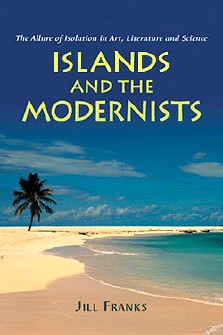|
Islands
and the modernists : the allure of isolation in art,
literature
and science / Jill Franks. - Jefferson (N.C.) : McFarland,
2006. -
VII-206 p. : ill., map ; 23 cm.
ISBN 978-0-7864-2457-3
|
|
ABOUT
THE BOOK
:
This study examines five modernists in different disciplines
— biology, painting, drama, fiction, and
anthropology — whose work on islands made them
famous.
Charles Darwin challenged every presumption of popular science with his
theory of evolution by natural selection, derived from his study of the
Galapagos Islands. Paul Gauguin found on Tahiti inspiration enough to
break through the inhibiting traditions of the Parisian art world. John
Millington Synge’s experience on the Aran Islands off the
coast
of Ireland gave birth to a new style of drama that defied classic
divisions between tragedy and comedy. D. H.
Lawrence’s
life-long search for a utopian community culminated in his famous short
story, The Man
Who Loved Islands,
that poignantly portrays the tension between idealism and realism,
solitude and human intimacy. Finally, Margaret Mead began her career in
anthropology by studying the remote South Sea Islands and through her
work acquired the sobriquet « Mother of the
World ».
The text explores the extent to which
islands inspired these radical thinkers to perform innovative work.
Each used islands differently, but similar phenomena affected their
choice of place and the outcome of their projects. Their examples
illuminate the relationship of modernism to alienation and insularity.
|
JILL
FRANKS :
[…]
Given
their bounded-ness and their distance from a mainland, islands suggest
themselves as both controllable and paradisiacal. For Charles Darwin
and Margaret Mead, the sense of control refers to the careful limiting
of their scientific or social laboratory so that hypotheses may be
specific enough to be tested thoroughly. For Paul Gauguin and
D. H. Lawrence, the fanciful idea of paradise compels, no
matter
how sophisticated their artists' minds. For John Millington Synge,
islands provide a hybrid space between art and science : Aran
gives him a language lab where Gaelic is spoken and a rich cultural
fabric waiting to be woven into drama for the rest of Ireland to
witness. For all five of them, their islands of choice are both literal
and imaginative spaces that function as crucibles for their creativity.
[…]
One
of the more exciting aspects of my research has been making interesting
connections across the fields and among the five historical figures
involved. For each of these five innovators, the balance between
isolation and togetherness, between tradition and innovation, between
reality and the imagination was difficult to achieve. Interdisciplinary
work share some of the same pitfalls and tensions.
[…]
Most
single-author books about islands that I have encountered during the
five years of my research have been more specific in focus than mine.
They have not been interdisciplinary, but written by geographers,
biologists, historians, political scientists, and economists. Islands and the Modernists
blends the four disciplines of evolutionary biology, social
anthropology, painting, and literature.
[…]
Islands are the place par
excellence
of dreams, so universal a symbol that Melville wrote,
« in
the soul of man there lies one insular
Tahiti, » 1
and Dea Birkett echoed him, a century and a half later, with the words,
« We all hold a place within our hearts
— a
perfect place — which is in the shape of an
island » 2.
☐ Preface, pp. 1-4
| 1. |
« For as this appalling ocean
surrounds the verdant land, so in
the soul of man there lies one insular Tahiti,
full of peace and joy, but encompassed by all the horrors of the half
known life. God keep thee ! Push not off from that isle, thou
canst never return ! » — Moby Dick,
Ch. 58 |
| 2. |
Dea Birkett, « Serpent in
Paradise », New York : Anchor books, 1997 |
|
| TABLE OF
CONTENTS |
| Preface |
|
|
|
| I |
Introduction : The Lure of Isolation |
| II |
« Isolated
Countries » : Darwin and the Galapagos |
| III |
« To Dream Before
Nature » : Gauguin in Tahiti |
| IV |
« Those Three Lonely
Rocks » : John Millington Synge and the
Aran Islands |
| V |
« The Man Who Loved
Islands » : D. H. Lawrence and His
Island Scheme |
| VI |
« The Cure for a Family Is a
Family » : Margaret Mead and Samoa |
| VII |
Island Dreams : Pitcairn as Paradigm |
| |
|
| Notes and Works Cited, Index |
|
|
| COMPLÉMENT
BIBLIOGRAPHIQUE |
|
|
|
|
- John M. Synge,
« Les
îles Aran » trad. et avant
propos de Pierre Leyris, ill. de Jack B. Yeats,
Castelnau-le-Lez : Climats, 1990, 2000
- John M. Synge,
« Théâtre
complet »
trad. de l'anglo-irlandais par Françoise Morvan,
Besançon : Les Solitaires intempestifs (Traductions
du
XXIème siècle), 2005
|
|
|
|
|
|
|
| mise-à-jour : 27
octobre 2017 |
 |
|
|
|